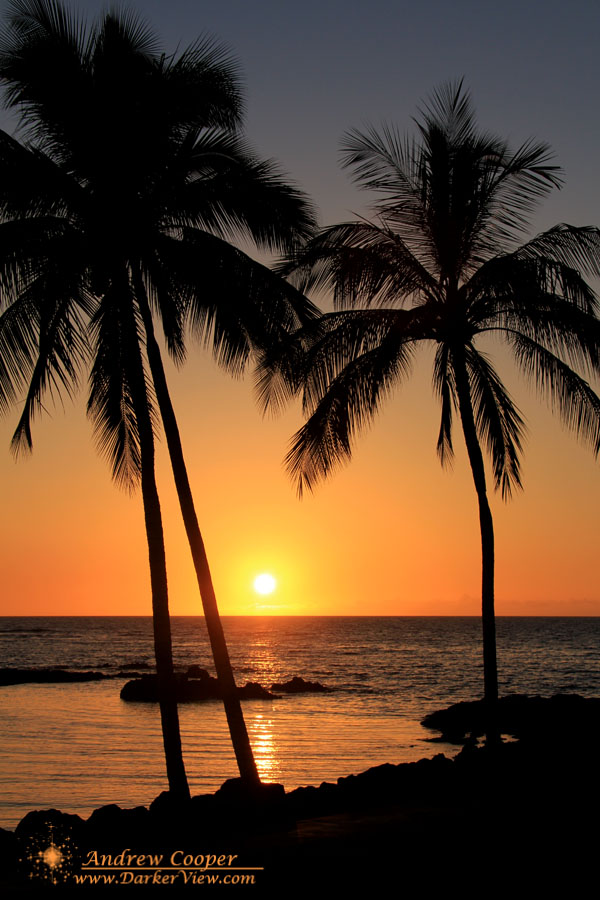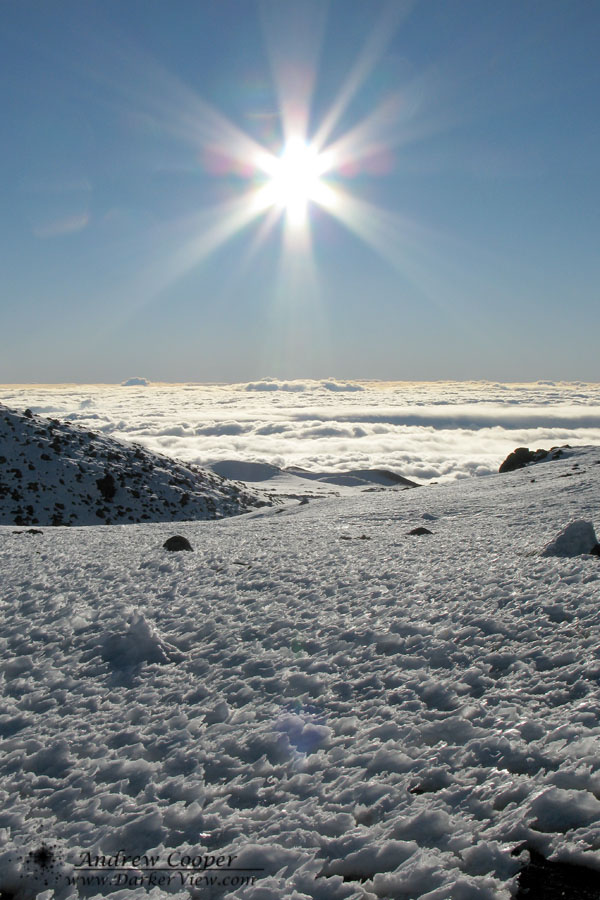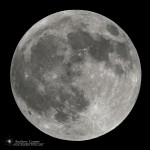
Winter Solstice
Winter solstice occurs today at 07:11HST. Today the Sun will occupy the most southerly position in the sky of the year. The term solstice comes from the Latin terms Sol (the Sun) and sistere (to stand still). On this day the Sun seems to stand still as it stops moving southwards each day and begins move to the north. This is the first day of winter as marked by many cultures in the northern hemisphere. Alternately, this is the first day of summer for those folks in the southern hemisphere.
| 2013 Solstices and Equinoxes | ||||
|---|---|---|---|---|
| UT | HST | |||
| Perihelion | Jan 2 | 00:59UT | Jan 1 | 14:59HST |
| Spring Equinox | Mar 20 | 11:02UT | Mar 20 | 01:02HST |
| Summer Solstice | Jun 21 | 05:04UT | Jun 20 | 19:04HST |
| Apehelion | Jul 5 | 18:59UT | Jul 5 | 08:59HST |
| Fall Equinox | Sep 22 | 20:44UT | Sep 22 | 10:44HST |
| Winter Solstice | Dec 21 | 17:11UT | Dec 21 | 07:11HST |
| Source: NASA Sky Calendar | ||||
Alignments
Through trial and error my friend Dean Ketelsen has worked out a perfect place and the correct dates to observe the Sun setting behind the telescopes of Kitt Peak National Observatory. The site is along the Mt. Lemmon Highway above Tucson, over 50 miles away from the observatories. The correct alignment occurs just a few days before and after the solstice. It has become a bit of a holiday tradition for the members of the local astronomy club to join Dean at the correct spot in an attempt to get just the right photo. This year the weather treated them well…
I have looked for a similar alignment on Mauna Kea. Unfortunately the telescopes are not highly visible from sites east and west of the summit where the Sun will rise or set behind. The full Moon might be possible, but much tougher to predict.
Comet ISON is Still Dead
The definitive results are in from the Hubble Space Telescope… Comet ISON is still dead.
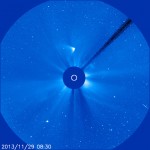
25th magnitude is a lot deeper than amateur attempts at recovery, though the amateur efforts likely covered a great deal more area than Hubble with wider fields of view. Still, there have been no reports of any remains detected by any searcher.
Does this rule out any surviving fragments?
We can’t completely rule out the possibility that something is left of the comet. After all, it was seen after its passage close to the Sun, but disappeared not long after. This material would still exist, but is likely very diffuse gas, dust, and very small pieces spread over an extremely large area. – Zolt Levay, The HubbleSite Blog
I think it is pretty safe to call this comet dead.
Postcard from the Universe – Christmas Tree Cluster
A seasonally appropriate astrophoto, NGC2264, also known as the Christmas Tree Cluster. It does have the outline of a tree decorated with stars in place of ornaments. This was shot on the evening of the 23rd from the driveway.
Keeping the exposures short I concentrated on the stars rather than the nebula that fills the region. I am working on the appearance of my stars, attempting to improve my technique. Not sure if I have succeeded here, they are better. I used some Photoshop tricks to preserve the color of the stars in working on the image. Better, but not quite up the the standard I aspire to.
There seem to be a few deep sky objects that are appropriate for the season. The Rosette Nebula makes a nice wreath, the Christmas Tree, etc. The folks at WISE published a nice infrared image of Barnard 3 that also looks like a wreath. Long winter nights are an excellent time to consider the night sky. Not much else to do, I am on call for the weekend, thus staying home. It is new moon and the recent storms have departed allowing dark skies. May as well take a few more astrophotos.
Mele Kalikimaka!
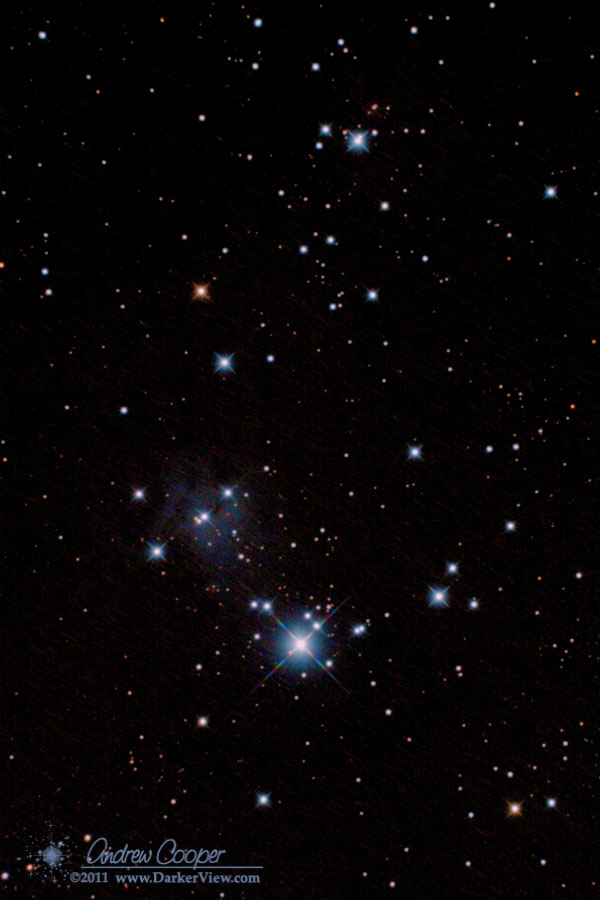
Epic Selfie
I am kicking myself that I only had the iPhone along in the basket. This has to be one of the most epic selfies. In a quick web survey of epic selfies, I find I am a distant second to one taken by Aki Hoshide.

The Rise and Fall of Galactic Cities
In the fable of the town and country mice, the country mouse visits his city-dwelling cousin to discover a world of opulence. In the early cosmos, billions of years ago, galaxies resided in the equivalent of urban or country environments. Those that dwelled in crowded areas called clusters also experienced a kind of opulence, with lots of cold gas, or fuel, for making stars.
Today, however, these galactic metropolises are ghost towns, populated by galaxies that can no longer form stars. How did they get this way and when did the fall of galactic cities occur?
A new study from NASA’s Spitzer Space Telescope finds evidence that these urban galaxies, or those that grew up in clusters, dramatically ceased their star-making ways about 9 billion years ago (our universe is 13.8 billion years old). These galactic metropolises either consumed or lost their fuel. Galaxies in the countryside, by contrast, are still actively forming stars.
“We know the cluster galaxies we see around us today are basically dead, but how did they get that way?” wondered Mark Brodwin of the University of Missouri-Kansas City, lead author of this paper, published in the Astrophysical Journal. “In this study, we addressed this question by observing the last major growth spurt of galaxy clusters, which happened billions of years ago.”
Icy Sunrise
Just Another Kohala Sunset
